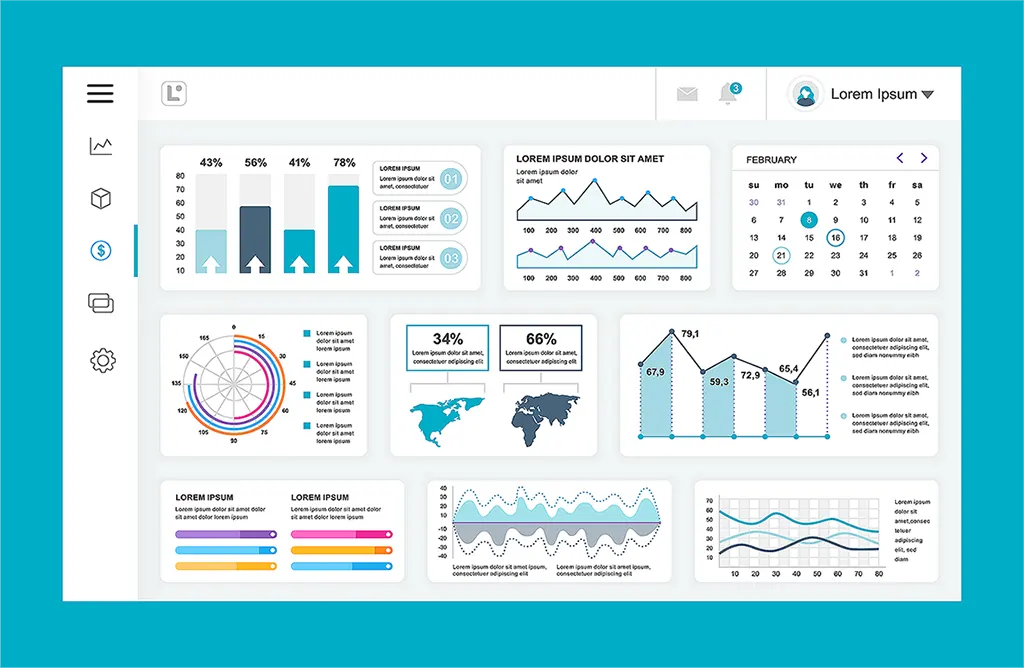Making informed Business Decisions Using Business Intelligence
to manage Mountains of
Data efficiently
to
Data
The mega trends globalization 🌎 and digitalization 💻 in particular mean that you are confronted with an incredible amount of information from a wide variety of sources. Dealing with big data can be a challenge at first. However, if using the right business intelligence tools, the whole thing offers a lot of optimization potential for your company.
What exactly is behind the Term “Business Intelligence”?
Why are sales rising in one region and falling in another? Where are there overstocks? You can get to the bottom of these and similar questions with Business Intelligence.
Business Intelligence (BI) stands for the technology-supported process in which data from different sources is collected, analyzed, processed and presented.
BI uses technologies, processes and methods to monitor, integrate, analyze and share data in real time.
Making informed Business Decisions based on Big Data
On this basis, companies can improve the decision-making process. The aim is to use the insights from the data to make the right decisions and thus optimize all business units and improve its profitability. In addition, a BI solution helps you to identify trends in the market and gain competitive advantages. BI communicates the findings from evaluations using dashboards, reports and visualizations in an understandable way.
Analyzing Data with the Help of OLAP and Data Mining
Business intelligence is based on OLAP - Online Analytical Processing - and data mining. OLAP makes it possible to analyze and visualize large amounts of data multi-dimensionally. The majority of business data is based on multiple dimensions, for example, sales figures can be broken down into the dimensions of location (e.g. a country or a region), time (e.g. a year or a month) and product (e.g. a category or a brand). OLAP is able to link and map all these dimensions, which leads to more insightful results and makes it possible to simulate situations.
Data mining, on the other hand, aims to recognize correlations within extensive databases and identify trends and patterns. Artificial intelligence (AI) techniques are used for this purpose. For example, it is possible to use data mining to prevent crimes before being committed.
Using BI, companies have the opportunity to use data not only to support their decisions, but also to use it as an impulse for their decision-making.
The Structure of BI

Business intelligence is based on raw data (data sources). This is data that is generated both inside and outside the company. Internal data includes, for example, data from the ERP or CRM system or data from supply chain management. External data can be usage data or statistics from the Internet, for example.
Based on this data, the data extraction, the transformation of the data and the loading of this data into the data warehouse (Extract-Transform-Load) are then analyzed with the help of OLAP and data mining. These analyses are used to produce reports, which form the management’s basis for decision making.
Business Intelligence: Methods for systematically using Data
Business intelligence solutions have a range of different tools and instruments. These include the most common methods:
- Queries: exploring a database based on a specific question.
- Visualizations: present data analysis in a clear and easy-to-understand way using graphs and charts.
- Reporting: communicating the results of data analysis to the people who will draw conclusions and make decisions based on them.
- Benchmarking: comparing current and past data with that of the competition.
Power BI: Microsoft’s Solution is also suitable for getting started with the Topic
Among other things, the low-code solution convinces with its simple application, quick deployment, its integration capability and the choice between different license types.
Power BI is made up of three different components that are closely interlinked: Power BI Desktop, Power BI Service and Power BI Mobile. This allows you to manage even very short-term changes to your database. You can also coordinate with your colleagues while on the move. And they can provide you with updated data in the cloud in real time, which you can access via your tablet or smartphone.
Self-service BI: performing Data Analysis without extensive IT Knowledge
Using Self-Service BI (SSBI), experts can carry out data analyses independently without having to rely on support from the IT department. It is necessary that your BI solution is integrated into a software platform.
Business Intelligence and ERP/CRM
More and more ERP and CRM systems also include business intelligence functionality, being integrated as standard. Thus, ERP or CRM and BI go practically hand in hand.
More information
on the topic Business Intelligence
on the


 Making data-driven Decisions
Making data-driven Decisions



